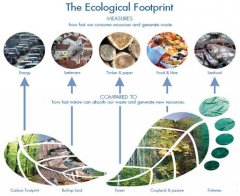Ecological footprint for students

Community Contributor | Clancy Wolf, PhD – IslandWood, WA
The other day as I walked along a sandy beach, I noticed a series of footprints from a bird. Two things struck me. First, that even a small bird weighing just a few ounces left a clear footprint showing where it had been. Second, I saw that the trail was disturbed by human footprints. In fact, as I looked around, there were many, many more footprints on the beach from people than from any other critters. All of this reminded me of the “ecological footprint” that we all create.
What’s an Ecological Footprint?
The idea of an ecological footprint is basically a measure of how much area is needed to support our lifestyles, how much land is needed to produce all the things we consume, and what is needed to clean up our waste.
The concept became so compelling that governments, educational institutions, NGOs and corporations started creating ecological footprint calculators to explore their sustainability practices. In 2006, a set of standards was created by the Global Footprint Network to make sure that all calculators were consistent and realistic. These standards were revised in 2009 and again in 2012. As a consequence, there are dozens of calculators available on the Web.
 Most of these calculators require you to answer questions about how you get to work, what you eat, how you heat your home, what kind of home you live in, and more. Based on this information, the calculator does some ecological accounting and quantifies the scope of your impact.
Most of these calculators require you to answer questions about how you get to work, what you eat, how you heat your home, what kind of home you live in, and more. Based on this information, the calculator does some ecological accounting and quantifies the scope of your impact.
For example, that bag of lettuce I used in my salad last night actually represents a chain of events that impacted the environment in ways that we often neglect to think about. First, a small piece of land was cultivated to grow the lettuce. It also took some gasoline to run the truck that brought the lettuce to me from California (where it was grown), so a small fraction of that truck’s energy use needs to be assigned to my salad. The gasoline used by the truck also put out 22 lbs. of carbon dioxide (CO2) for each gallon, so my footprint calculation should also account for the ecological costs of growing the plants that pull that extra CO2 out of the atmosphere.
The upshot is that in order to accurately measure your ecological footprint, you need access to some extremely detailed information.



|
Inquiries in Science: Conserving Resources Kit BISS (Carolina Biological Supply Company)
|